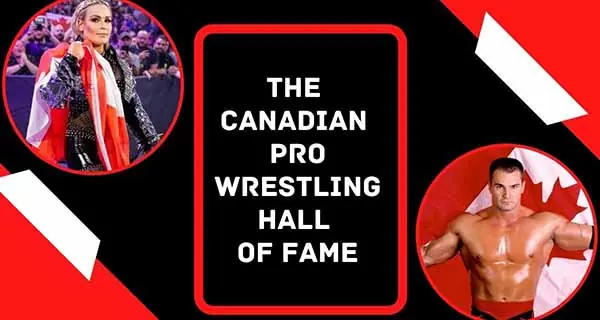With the death of Joyce Grable on September 29, at age 70. from leukemia, the women of pro wrestling lost both a “big sister” and a “wrestling mom.”
Though Fabulous Moolah gets all the credit for running women’s pro wrestling from the 1960s into the 1980s, for the majority of the 1970s and ’80s, it was Grable (Betty Wade-Murphy) who was the one in the ring, actually training the next stars of women’s wrestling. And that didn’t stop when Grable left Moolah’s compound in Columbia, South Carolina, either.
There is an entire generation who owe their careers to “The Golden Goddess of the Mat.” One of them was Bambi / Selina Majors. “It’s ironic that you trained me. I didn’t go to Moolah’s school, and I’m glad I didn’t because you’re the best teacher ever, and you’re my Wrestling Mom, Big Sister, whatever, and I love you with all my heart,” said Majors when she was honored at the Cauliflower Alley Club reunion in 2019.
Grable was their trainer, often their first true match, their travel companion, their confidant, their friend.
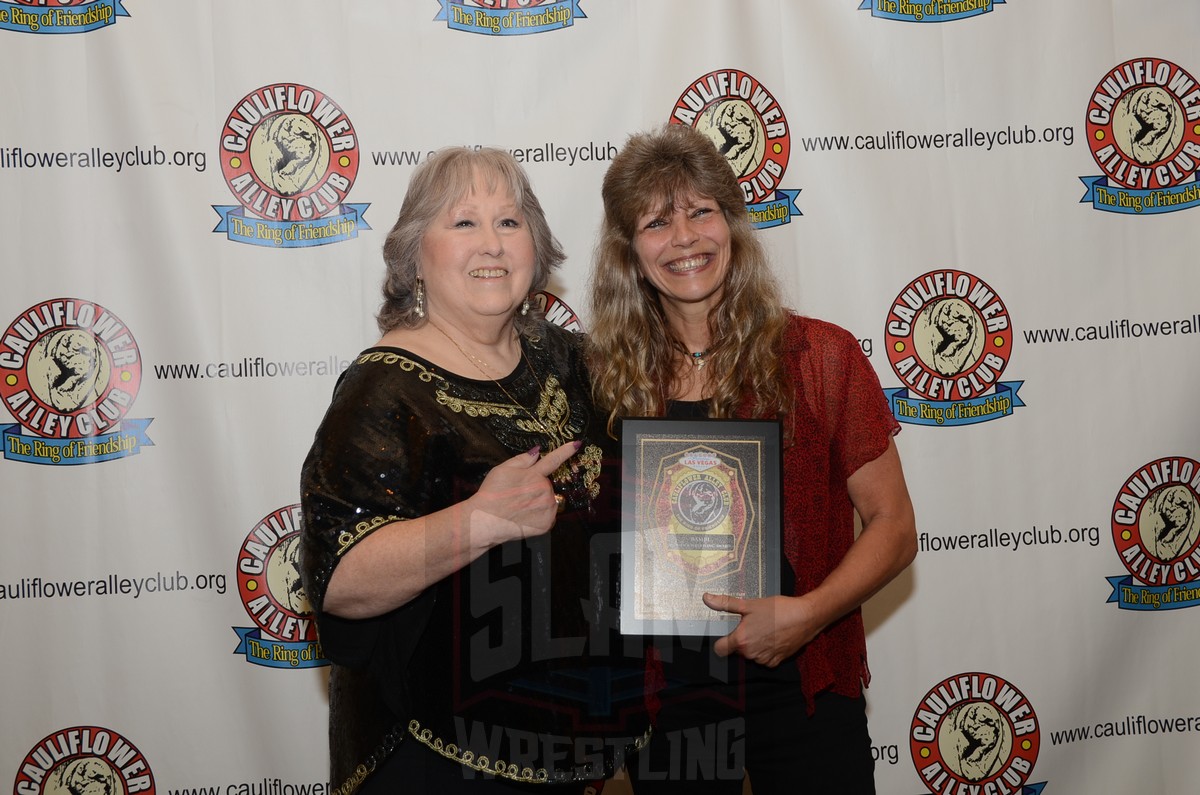
Joyce Grable and Selina Majors at the 2019 Cauliflower Alley Club reunion. Photo by Brad McFarlin
As Leilani Kai once wrote in LadySports magazine, “Joyce Grable spent a lot of time making other wrestlers look good.”
When Grable was inducted into the Pro Wrestling Hall of Fame in May 2013, Wendi Richter — yes, one of her students too — spoke about Grable at the podium in Johnstown, New York.
“I feel so honored to induct Joyce Grable into the Professional Wrestling Hall of Fame because nobody deserves this award more than she does,” said Richter, listing a long list of Grable’s accomplishments. “She’s one of the greatest professional wrestlers, man or woman, of all time. She helped train me as well as a hundred other ladies — without compensation. We all paid our money to be trained, and they gave us Joyce Grable. When we went on the road, most of our first tours were with Joyce Grable. I learned so much from that, and I am so grateful that I was able to have that experience and learn from this. The other girls at the table, I’m sure they feel the same way, the same things with them. I have so many good memories, and so much fun with Joyce. I always felt like she had my back, both in the ring and outside of the ring. She’s such a good person and a wonderful friend. She’s been my mentor. She has dedicated her life to wrestling and she continues to be involved in the sport.”
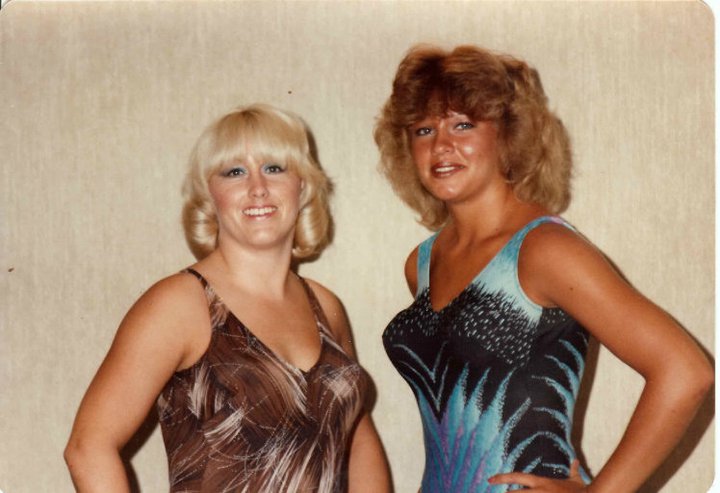
Joyce Grable and Wendi Richter, 1981, in St. Lous. Photo by Darla Staggs
That was true in 2013, and it was true in 2022, when Grable received a surprise Courage Award at the Cauliflower Alley Club reunion in Las Vegas. Pro wrestling was her life, and was a frequently-quoted for SlamWrestling.net stories — she was, after all, connected to almost every woman in pro wrestling.
Betty Murphy was born November 9, 1952, in LaGrange, Georgia, to Lonnie Murphy and Clara Nell Raile, and attended Lagrange High School. She had seven siblings, including four older brothers, so was constantly challenged to be tough to hang with them. Watching pro wrestling was part of their fun, but she never really planned on a career in the business.
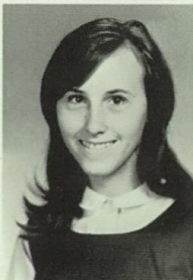
Joyce Grable in high school.
Wade-Murphy had a friend who enjoyed wrestling and wanted to get into it. They traveled together to the matches in Atlanta, where they knew Fabulous Moolah (Lillian Ellison) was on the card.
“My friend wanted to go to Atlanta because Moolah was wrestling there, and she wanted to talk to her about training to wrestle,” Wade-Murphy told the Cauliflower Alley Club website. “After Moolah’s match, she was walking across the stage, and Moolah stopped to talk to my friend. She noticed me, this skinny little girl, and told my friend she would agree to train her, only on the condition that I come with her to do it, too. She told Moolah I wasn’t interested, but when it was both of us or neither, I was talked into it! We packed our bags, and it wasn’t two weeks later that I was in the ring doing dropkicks and the flying headscissors.”
Or, as Wade-Murphy told filmmaker Christopher Annino, “I was in the right place at the right time and I was very honored that she would consider training me.”
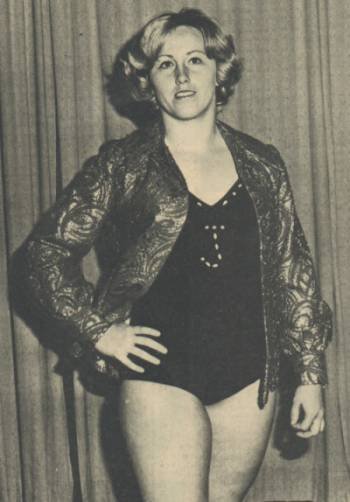
A young Joyce Grable.
Grable always had good cardio, and enjoyed road work. She once detailed the in-ring training at Moolah’s camp in Columbia. “We had to train twice a day, three hours each time. You were so sore and tired,” she said. “The older girls led the matches, told you what to do, and that was how you did it.”
That was 1971, and before debuting, Murphy needed a name. Moolah went to the past.
The original Joyce Grable was Joyce Fowler, and you’ll find her listed as Joyce Becker too, as she married fellow wrestler George Becker.
“When I was ready to start, (Fabulous) Moolah asked me if I’d like to take that name, because I looked so much like her. So that’s what I did. If you look at pictures of the two of us, you will see a lot of similarities in our features,” Grable told the CAC’s Jeff Sharkey. She added that she often got photos of the original Joyce Grable sent to her, but she’d send them back, unsigned, with a note explaining the situation. (And, for the record, she wasn’t related to “The Barefoot Contessa” Judy Grable either.)
The new Joyce Grable debuted on the massive Super Bowl Of Wrestling card in Municipal Stadium in Cleveland, Ohio, on August 12, 1972, promoted by Johnny Powers‘ NWF. There was a Women’s Tag Team Tournament on the show, and Grable teamed with Tanya West to beat Dottie Downs and Paula Kaye in her first match, and then wrestled again that day, teaming again with West in the final to Lilly Thomas and Susan Green. “I wasn’t even supposed to wrestle that night,” Grable once told this writer.
Tag team wrestling would be a big part of Grable’s early wrestling days.
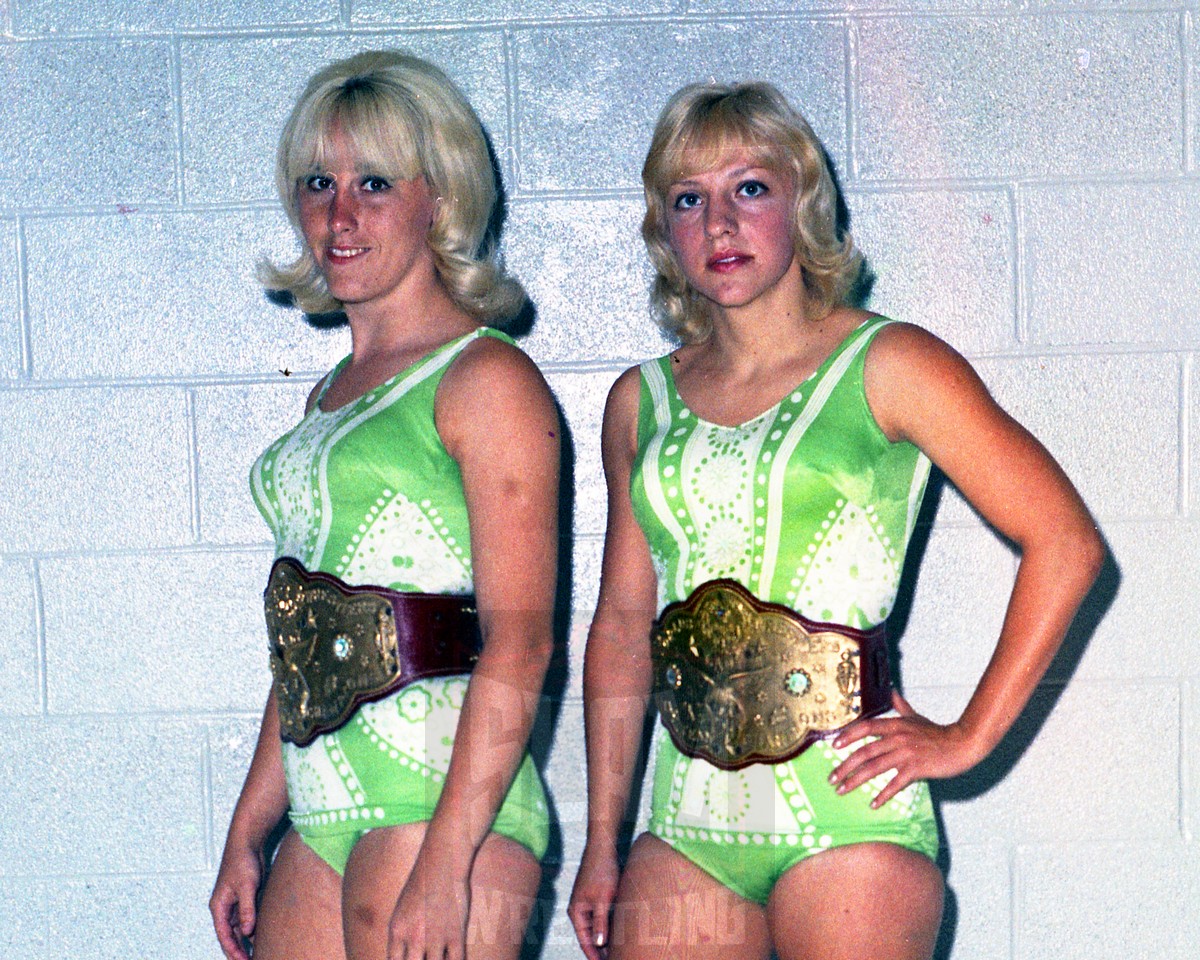
Joyce Grable and Vicki Williams as NWA World Women’s tag team champions. Courtesy the collection of Chris Swisher
Vicki Williams, another young blonde wrestler, was a frequent partner. There was a contrast in styles. “Vicki was more into the flying and taking big bumps; I was more of the style of ‘grab a hold and hang on to it’, you know? Together, we were really good,” Grable told Sharkey. Together, they won the NWA Women’s World Tag titles on October 15, 1973, beating Toni Rose and Donna Christantello in New York’s Madison Square Garden.
After Christantello died in 2011, Grable praised her opponent: “She would give you anything if in need. My best matches as a babyface was against her and Toni Rose. They trained me in how to be a good wrestler. I had fun with her. We never had a fuss and were on the road for six months at a time.”
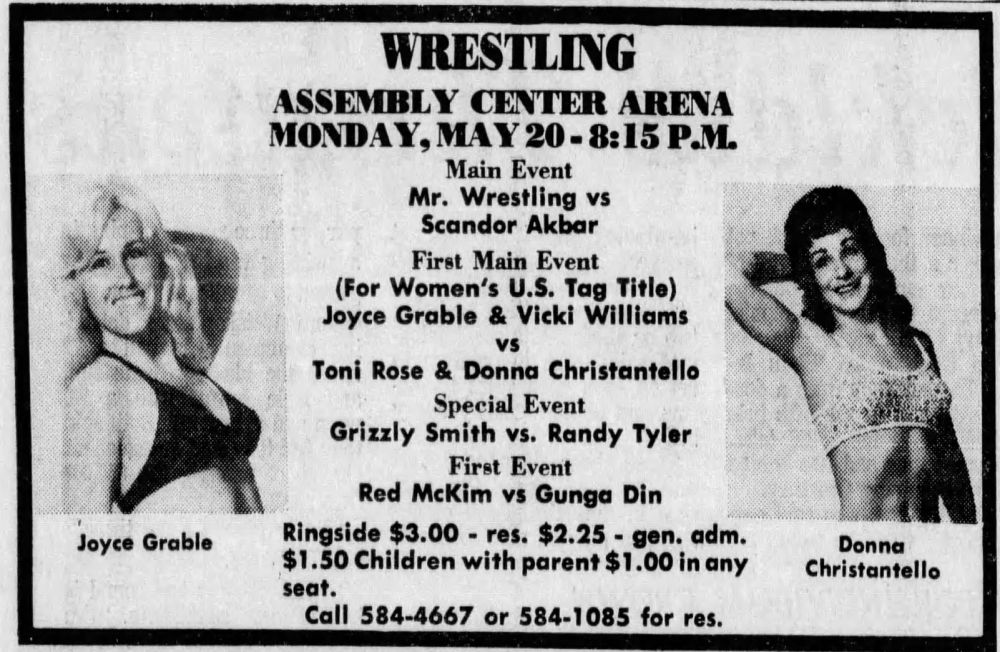
Joyce Grable and Donna Christantello are featured on this card from Tulsa, OK, on May 20, 1974.
Indeed, the women wrestlers of the 1970s lived out of suitcases. It was a truly crazy touring travel schedule. “We tried to avoid criss-crossing the country. A typical tour would start out in New York, and from there we’d go to Minneapolis… Calgary… California… Texas… into Louisiana for Bill Watts… Alabama, and then home,” Grable told Sharkey. A tour could last six months. “It could be tough, because you couldn’t have a dog, or keep any plants, because they’d turn brown! For everything you got, you had to give up something.” There were international trips too, to Japan, New Zealand, El Salvador, and all of the Caribbean.
Murphy’s first marriage, when she was 25, ended in divorce; in fact, she claimed that Moolah booked her more after learning about the marriage. She has one biological son, Derek Murphy, born in 1985, and helped raise a stepdaughter, Melissa Wade, and a stepson, Richard Wade.
In 1998, her husband, Richard Wade, suffered a massive heart attack and doctors couldn’t operate because of his diabetes. We had no income coming in, we had three children,” Grable recalled. Her old teacher, Moolah, rallied the troops even though Grable hadn’t worked for her for 14 years. Money came in from old colleagues, promotions and promoters, and fans, thanks to Moolah’s hustle.
There’s raising kids and there’s raising wrestlers. Many considered Grable their mother figure in wrestling. Where Moolah might portray a Southern Belle, Grable acted far more maternally towards her friends and colleagues. The lessons were far beyond how to take a bump.
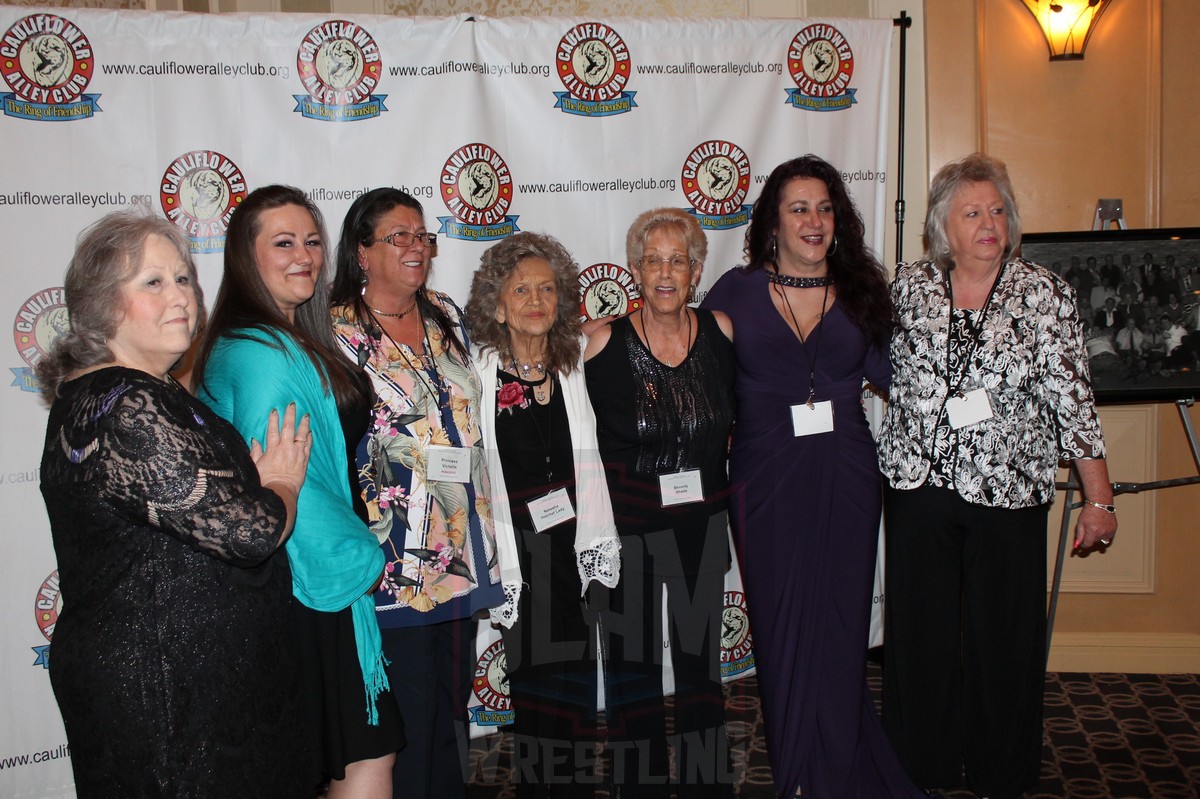
Joyce Grable joins a group photo of some of the women at the 2018 Cauliflower Alley Club banquet in Las Vegas, including, from left, Raven Lake, Princess Victoria, Natasha the Hatchet Lady, Beverly Shade, Despina Montagas and Judy Martin. Photo by Greg Oliver
At the 2018 Cauliflower Alley Club reunion, she was a part of a panel that talked about the legacy of the Fabulous Moolah — good and bad. There were taught decorum, noted Grable: “When you went in an arena, you looked like a lady. You looked like you had a million dollars; you might not have known where the next meal was coming from, but they didn’t know it. We dressed, we had our makeup on, we had our hair fixed, we didn’t wear shorts to the arena, we either wore a dress … we looked like lady wrestlers.”
Early in the discussion, Grable looked at the rest of the women on the panel, and said, “I had a hand in just about everybody at this table, training ’em.” That included Peggy Lee Leather, Despina Montagas, Princess Victoria, Judy Martin, and Malia Hosaka, and Beverly Shade existing outside Moolah’s control.
Selina Majors was trained in Grable’s backyard, after Grable had stopped actively wrestling — but she never gave it up.
The fondness Grable had for other women wrestlers was evident at the CAC panel. “We traveled together. No one ever saw us together, because it was strictly kayfabe from word go. We had fun. I’m glad that today we can live to talk about it in public, whereas it used to be you couldn’t,” she said.
Near the end of her run with Moolah, Grable teamed with one of her trainees, Wendi Richter, as the Texas Cowgirls. Another major moment was a notable 1980 bout at the Omni in Atlanta, where she teamed with Judy Martin against two men, Jerry Roberts (Jacques Rougeau Jr.) and Steve O — written about extensively in Battle of the Sexes: Men vs Women tag in Atlanta.
But make no mistake, Moolah was in charge for most of Grable’s career — at least the 13 years she worked for her, leaving in 1984.
“She was my boss. She told us what to do, how to do it and when to do it. But when we were outside of the ring, we were on our own time,” said Grable, adding that men weren’t foreign to the Moolah compound, just complicated. “I had to sneak ’em in if I wanted ’em!” she laughed.
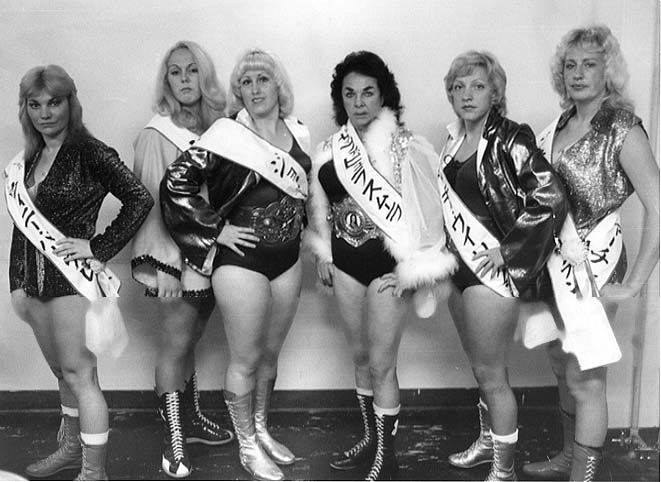
Moolah’s girls in Japan; from left, Wenona Little Heart, Leilani Kai, Joyce Grable, The Fabulous Moolah, Vicki Williams and Judy Martin.
You learned how to protect your own interests, said Grable. “I could walk out to the arena, I knew what the price for tickets were in that arena, I could almost tell you, within $10, what my pay was going to be for that night. Once you’re in it, and you know how to judge a house, you know what your pay’s going be. You can question it if you don’t like it.”
And Grable was a trusted lieutenant of Moolah’s. “I eventually became the one who had stayed with Moolah the longest, and she depended on me while she was touring,” Grable told Sharkey. “I took care of collecting the booking fees, and getting the girls on the road. The last four or five years, I was taking the new girls out on the tours.”
Grable suffered plenty of injuries through the years. She broke her collarbone, which kept her out six weeks. There was the dislocated right shoulder, a cracked vertebrae in the neck, a pinched nerve caused by a slipped disc. Her career ended in 1991, after another seven years wrestling part-time in Georgia and Alabama while holding down a full-time job.
Her biggest foe, though, was cancer.
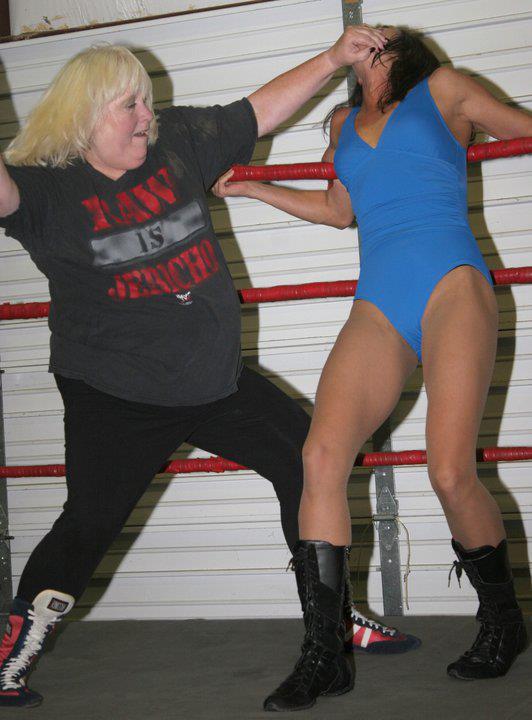
Joyce Grable strikes Sabrina during her comeback for a custom match in 2013. Facebook photo
Just before Grable turned 60, she was back in the ring in Florida, doing a women’s custom match with a few other veterans, like Leilani Kai, Diane Von Hoffman, and Sabrina. However, to get ready for the in-ring action — five matches in all — she’d had a cyst on her foot removed. After the matches, Grable got a call that she needed to return to Georgia as her platelet count was low. It was MDS, a blood disorder that often leads to leukemia.
Intense chemotherapy was needed, which would destroy any cancerous bone marrow; she would receive healthy stem cells donated by her sister — but not until after her Pro Wrestling Hall of Fame induction in May 2013. At the podium, she talked about the fight ahead: “I ain’t putting it over, I’m not putting nothin’ over. I’m going to beat it because I am one, old, tough woman.” Grable would be inducted into the St. Louis Wrestling Hall of Fame in the Class of 2022 as well.
Doctors also wondered how she had wrestled for 20 years with only two valves on her heart, where the norm is three. A pig’s heart valve was inserted in 2013. “No wonder I’m fat!” she liked to joke.
The leukemia was gone, at least until late 2021, where things got dire again. She was hospitalized in the summer of 2023, and, on September 24, it was announced that she was moving to hospice care.
For those who were there, Grable’s speech at the 2022 Cauliflower Alley Club banquet after receiving the Courage Award was one of the highlights of the reunion.
But her Pro Wrestling Hall of Fame induction speech perhaps speaks better to her legacy:
I love wrestling! If I was 20 years younger, I’d still be out there giving the bumps — giving them, not taking them. But you know, things change, we all get a little bit older. But, if you don’t love what you’re doing, get out of it, because you’re not going to be good at it. All the girls I trained, I loved every one. I tried to make them the best that they could be. Moolah saw me sitting at ringside and she said, ‘That’s a pretty blonde-headed girl there. Do you want to be a wrestler?’ ‘Huh? Huh?’ I weighed 120 pounds. I didn’t wrestle. She said, ‘Bring her with you, and I’ll train the both of ya’ll.’ I stayed there with her for almost 15 years. Then I decided I wanted to have a baby. I thought, ‘I’m getting older, I want a baby.’ I decided that I’d better quit, especially if I was going to have a baby. I shouldn’t be out there taking bumps. But I had fun.
Her son, Derek, organized a GoFundMe account to help with expenses related to her last days at home in hospice care. “She has lived a long fulfilling life and is ready to be with the Lord,” he wrote.
On September 29, Derek posted: “Rest in Heaven to my wonderful mother; Betty Murphy AKA ‘Joyce Grable” The Golden Goddess’; 11/09/1952-09/29/2023:
Wade-Murphy is survived by her three children.
The funeral for Joyce Grable will be on Tuesday, October 3, at Higgins Funeral Home in LaGrange, Ga. Visitation will be from noon to 1:00 p.m., with the service starting at 1:00 p.m. Burial will follow at Restlawn Cemetery in LaGrange. Rev. Jimmy Powell and Rev. Bobby Simmons will officiate.
TOP PHOTO: Left, Joyce Grable in her wrestling prime, courtesy the collection of Chris Swisher; right, Joyce Grable at the 2014 Pro Wrestling Hall of Fame induction, photo by Andrea Kellaway, www.andreakellaway.com
JOYCE GRABLE PHOTO GALLERY
[modula id=”156543″]
JOYCE GRABLE STORIES
- Oct. 5, 2022: Joyce Grable’s beautiful CAC moment
- May 10, 2018: Complicated legacy of Fabulous Moolah on trial at CAC
- May 18, 2013: Back and forth repartee keeps Pro Wrestling Hall of Fame induction hopping
- Apr. 11, 2012: Battle of the Sexes: Men vs Women tag in Atlanta
- Dec. 16, 2010: Knocked out by the growth in women’s wrestling
- Apr. 14, 2010: Joyce Grable to be honoured by CAC


